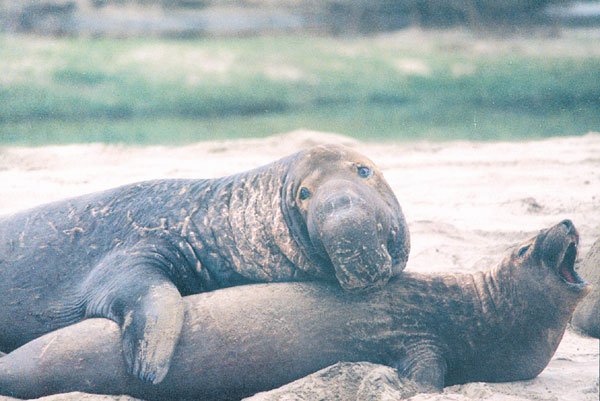They are big, lolling creatures. They haven’t a care in the
world, bar about 500 baffling humans a day and the toil of winning
a mate.
Add the 1,678 newborn pups to the 4,452 adult elephant seals
this migration season, according to Marty Foxworthy, park ranger at
A
ño Nuevo State Reserve, and you have a quite a herd.
They are big, lolling creatures. They haven’t a care in the world, bar about 500 baffling humans a day and the toil of winning a mate.
Add the 1,678 newborn pups to the 4,452 adult elephant seals this migration season, according to Marty Foxworthy, park ranger at Año Nuevo State Reserve, and you have a quite a herd.
Every winter beginning around mid-December, elephant seals migrate and come ashore in droves to the 4,000-acre reserve on Highway 1 near Pescadero, halfway between Santa Cruz and San Francisco. Guided tours are available daily until March 31.
The blubbery residents of Año Nuevo were almost hunted to extinction by the 1800s for oil. By 1892, only between 50 and 100 were left on Guadalupe Island off the coast of Baja California. From this, the animals revived and come every December to Año Nuevo.
Now at the landmark reserve, the alpha males – which can reach 5,000 pounds – have managed to beat away the beta males and younger bulls, and have ended up with the prize, a harem of females. There’s a lot of shouting, bellowing and screeching as you walk toward Bite Beach or Tar Sands.
Unable to rotate around on its flippers, the elephant seal is still a pinniped with finlike feet, but these don’t work quite like those of the sea lions who gather on Año Nuevo Island nearby. Named for the male’s outstanding schnoz like an elephant’s trunk, the elephant seal is a belly-mover. It can’t use its peds to rotate, but can it move when it has to.
Rule No. 1: stand 25 feet away, preferably with your docent.
“It can take three seconds for an elephant seal to go 25 feet,” said Molly Elie, the docent on our tour. Surprise. They’re not slow when chasing females or when threatened.
Thirty-day-old weaners, those deserted by mom after a month, must learn survival on their own. One loner rippled up the dune. Newborns are about 90 pounds, and weaners can gain 250- 300 pounds quickly.
A “super weaner” eyed us from under a windswept dune, and looked like a small sub. A “super” may reach more than 300 pounds in a month.
The mother seal’s milk is among the richest of mammal milks, being about 55 percent fat, Elie said. Males are the first to arrive, to do battle for dominance and the right to “own” harems. Females arrive later, first to give birth from the previous year. After about a month, the pups are released, and the female attempts to return to the sea. The males will then mate with the females as they return to the sea or with those in harems. During this time, the reserve, the site of the largest mainland-breeding colony in the world for the northern elephant seal, is closed except for guided tours.
“Younger males who aren’t going to make it with the bigger males find themselves on Loser’s Beach, which is what we call it,” Elie joked.
Off shore, an alpha male poked up. It snorted and snorkeled. “It kind of sounds like a cross between a Volkswagen and a water vent,” Elie said.
Sneezes, gurgles, squalls, shrills, burps and general moving around and galumphing went on at nearby harems among the females, newborns, weaners and commanding alpha bulls. The betas slept on the beach.
The seals sprayed sand up into the air and flipped it over their bodies like steam shovels. “No one knows for sure why they do this,” said Elie. “We think it’s to keep cool or a nervous reaction.” You can tell which ones are the newborns because they are next to mom’s side, black in color, and have high-pitched, “monkey” squeals, said Elie.
It’s a great place to escape to nature, or to take the family. The 2-and-a half-hour guided tour from the Visitor Center is led by trained volunteer docents.
With a little humor and imagination, the reserve adjoining Año Nuevo State Park, with its whispering ocean and warm spring winds, can be a day away from it all, if your thing is to peek into the intimate lives of elephant seals during mating season. The trip time is about one-and-a-half hours from South Valley.
The Marine Mammal Center only answers calls in the reserve when seals are in danger, like the time one was freed from a toilet seat caught around its head in the water,” Elie said. “Otherwise they are on their own. We have 250 bird species, too. It is incredible. The seals are living here and doing so well.”
If you go …
Tours: From the Visitor Center, the trek out with a docent to see the elephant seal colony is about three miles round trip. Wear sturdy hiking shoes and a windbreaker with a hat and sun block. Take a camera, binoculars and lunch. Back at the center, there are picnic facilities. The maximum is 20 people per tour for the public and school groups. The walks are by reservation only until March 31.
Info: To make a reservation, call 1-800-444-4445. The California State Parks Web site is www.parks.ca.gov. Click on “Find A Park.”












